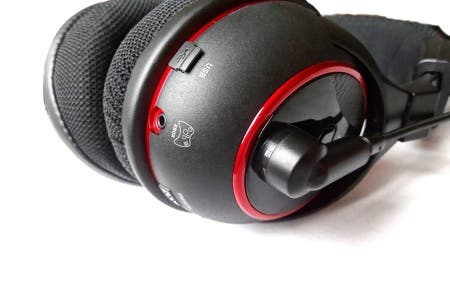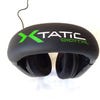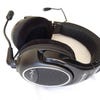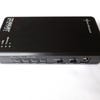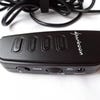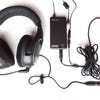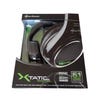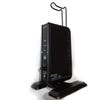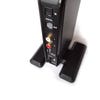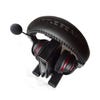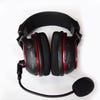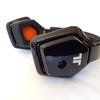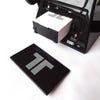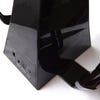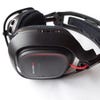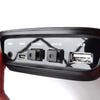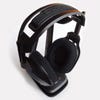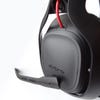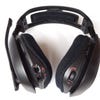Surround Sound Headset Face-Off
Sharkoon X-Tatic Digital, Turtle Beach PX5, Astro A50 and the Tritton Warhead 7.1 put to the test.
One of the biggest revolutions for console gamers over the last decade has been the ability to connect to millions of other players online, where the standard of play has risen quite sharply since the days of playing split-screen with some friends. The itch to gain an edge in games like Call of Duty: Modern Warfare 3 - to pick a random FPS name out of a hat - is a compulsion that can lead down several paths. For some, choosing a third party MLG-branded gamepad appears to be the sure-fire ticket to success, while others might see splashing out on a HDTVs known for its minimal latency as a more sensible bet. However, it seems one of the more popular ways to "up your game" in recent years is to take to the world of surround sound headsets.
There is some logic to this, as reflected by the gear of choice among e-sports high-flyers. In visual terms, a restrictive field of view can be a one of the greater obstacles in playing these games competitively. Every inch of screen space demands careful direction when winding through corridors, and the reticle necessarily needs to be traced against the edge of every upcoming corner to maintain the best chance of surviving a one-on-one encounter. But when there's no telling what might be sneaking from behind at these moments, it's fair to say a high value is then placed on details gleaned from the 360 degrees of aural information being made available.
That's all well and good for 5.1 speaker set-ups, but making this possible within the confines of a pair of headphones poses some interesting challenges. There are differing approaches when it comes to engineering the effect for a single user, with both hardware-based and the virtualised methods currently doing the rounds. We take a close look at shining examples of both, having access to the absolute best-in-class models available from the likes of Sharkoon, Turtle Beach, Tritton and Astro, to get a feel for which implementation works best in practise.
Sharkoon X-Tatic Digital: True 5.1 Hardware For Less Than £100
The cheapest of the quartet is Sharkoon's X-tatic Digital, unique for its offering of the aforementioned hardware-based surround sound. Specifically, this is achieved through the integration of eight speakers in total, where each earpiece contains a 30mm front speaker, a 27mm rear speaker, a 30mm centre speaker, and a 40mm subwoofer to supply the bass. To drive all of this, the big sacrifice being made here is that it must be wired at all times, via a 9-pin connector to the supplied sound control unit.
In theory set-up is quite simple: we plug the Toslink cable from the PS3 or 360 into the back of the control unit, and have either console set up in their respective dashboards to deliver 5.1 Dolby Surround Sound. From there, we plug the headset into either one of the ports at the front. An issue arises once we piece it all together and realise it's necessary to power both the control unit and the headphones via one AC adapter. This makes for a large mess of wires that can be difficult to minimise. Side-stepping the issue of replacing batteries is certainly a plus here though, but those looking to keep their gaming set-ups tidy and elegant should approach this one with caution.
Much of the control is conducted through the in-line remote. This features four LED backlit buttons on top, each representing the speaker pair you want to customise, where you can alter the volumes for front, centre, back or subwoofer speakers individually. Colour coding is used to denote the different levels, with green being quietest, and red being loudest - an acceptable stand-in for the lack of equalisation controls. Looking out the options on the sides of the remote, we have a general volume toggle, and a 2.5mm connector for 360 headsets which links to the gamepad. PS3 users are also covered for voice chat features, as thankfully the microphone can linked via a direct USB cable connection to the console.
Once we're all set, we put to test the actual sound quality of the headphones, and the effectiveness of the control unit's processing. Loading up Killzone 3 causes the LED to switch from the standard stereo Dolby Pro Logic signal to 5.1 Dolby Digital, and we immediately take to a Warzone game on the popular Bilgarsk Boulevard stage to hear it in action. It must be said, spawning indoors here gives us a great initial sense of the Guerrilla Games' impeccable sound design. Among the series' many other technological achievements, the latest two entries have been advertised for their use of audio occlusion and simulated wave tracing, allowing for sounds to convincingly reflect against the geometry of a map.
The surround sound effect takes advantage of its source material well, but ultimately, we find it to be on the subtle side. We struggle to distinguish between the forefront and the background when walking around a noisy propaganda speaker in-game, which leads us to believe something hasn't been set up correctly with the main unit itself. In reaction we look to the Time Delay switch on the control unit for answers, allowing us to create an artificial disparity between the central and surround speakers - essentially widening the sound-stage. Straight away, this greatly helps to increase our sense of place within the mix. In practical terms, it means allies shuffling behind us immediately become easier to track when this is enabled, though getting greedy and tapping the plus button one too many times does cause the mix to become confusing. We strike a happy middle ground at five clicks upward, where the reverberation isn't too overbearing, but still get a good sense of the effect
The results are on par with expectations of a true hardware-based 5.1 surround sound being planted directly to our ears, and we're satisfied that the results now at least live up to the company's long reputation in the field. Speaking purely in terms of sound quality from the headphones though, we find the lower and mid-range are well tuned for most gaming purposes, though the harsher treble sounds we hear cropping up during gunfire can come off as a tad compressed. This is nitpicking more than anything, and can partly be offset by raising the bass channel volume slightly.
On the quieter end of the spectrum, a faint mechanical whine can be heard during moments of pure silence, such as when browsing menus. This is a little like the capacitor whine we sometimes hear from PCs under load, though we really need to perk our ears up to pick it out here. This is a surprising quirk, given that a direct wired connection to the source should give us far clearer signals than those of wireless pairs.
Turtle Beach PX5: Taking Virtualised Surround Sound To the Battlefield
Next up, we look to Turtle Beach's successor to the X41, dubbed the PX5. Here we hope to see if the patented Dolby Headphone processing method has a more convincing delivery of the surround sound effect. This is the virtualised approach - quite similar to Creative's CMSS-3D feature on newer X-Fi sound cards. In simple terms, the process takes up to a 7.1 signal from a console's optical port, and then mixes it down to just a stereo output for any conventional pair headphones to use and enjoy, with the complete surround sound mix intact.
But how is this possible, when the resulting sound can only arrive from two angles? The provided headphones are strictly stereo, of course, using two speakers like any other. However, it's the processing on the supplied Digital Audio Processor that creates the illusion of a full 3D space. The key is in a head-related transfer function (HRTF) algorithm applied to each channel, which forces a slight delay between each, and a treatment to the frequencies on background and foreground elements.
The aim of the algorithm is simply to simulate the effect the outer ear has on passing sound-waves before routing through to the ear-drum, be they coming from in front, behind or above. The science of sound is a strange beast, particularly when considering that all mammals sense through just two points to either sides of their heads. In the end, it's the slight alterations to incoming sound that allows the brain to establish whether it has its origin in the foreground or background, rather than just placing it on the spectrum of left to right. This interpretation of incoming sound is the one Dolby Headphone processing aims to take advantage of.
With that in mind, we take a look at the hardware making this possible. Supplied in the box is an upright-standing sound control unit, which also serves as the dock and wireless transmitter for the headphones. It has the optical input on the back, but rather than being powered by the mains, is conveniently driven by a USB port from any active device. The one other major difference between this unit and that of the Sharkoon's is the presence of a 3.5mm audio port on the front, allowing us to plug in any pair of headphones we may already have lying around.
As for the design of the headset, the move to a wireless format means that all controls have migrated to the underside of each ear-cup rather than being squeezed onto an in-line remote. It's tricky to familiarise with, and trickier still to navigate blind - but once well acquainted with over the course of a week it begins to sink in. To the left we have volume, mute and sync controls for its dual-band Bluetooth transmitter, which is able to communicate with the PS3 for voice-chat purposes. The most fiddle-with controls are positioned to the right though, where we find the volume scroll, a button to switch between nine built-in equaliser presets, a 2.5mm port to connect wire its microphone up to the 360 gamepad, and also a mini-USB port.
The last input bears mention for its ambition. It allows us to connect the headset to a PC, and with Turtle Beach's software, customise a further nine equaliser settings to our liking, or simply transfer across the game-specific profiles available on its website. Alas, the one flaw in this plan is that there's no preview function, meaning we need to upload our new profile to the headphones memory banks before getting wind of the results. The program also gives us the option to edit the way voice morphing works (if you're that way inclined), or tweak volumes for microphone monitoring.
The headset is much lighter than the Sharkoon's, using a breathable nylon mesh for cushioning on the headband and ear-cups that reduces sweat-build up over hours of play. Pressure on the ears is minimal too by comparison, and we're pleased to see that the microphone can swivel up and down in parallel with its height, rather than just bend around. It's a comfortable set, and the red lining against its matte black plastics gives it a appropriately sleek look for its high price-tag.
Now, onto sound quality. The use of a 2.4GHz RF signal for reception does have its issues here, and we find the headset crackle on occasions when it loses the line of sight of the transmitter. However, the distance it operates at is impressive when dealing on these terms; even at 10 metres we get a clear signal without any sign of interference. This is being tested in a relatively quiet neighbourhood though; your mileage may vary in densely populated areas since its frequency of choice happens to be common to many wireless routers. The other concern with going wireless is obviously battery life. Alas, power is leveraged through two AA batteries for this model, though we were pleased to get over eight hours of play from the box-in pair. Replacing these is relatively simple, being accessible by sliding down the red-lined plate on the left cup.
"Try out the virtualised surround processing yourself with your own headphones by checking out this Skyrim video which switches between standard stereo and '7.1' audio."
Put in practise with games like The Elder Scrolls V: Skyrim, we notice the spatial positioning of objects immediately coming through. When an arrow whizzes past our heads during battle, we can hear its wooden shaft clatter against the floor behind us, and proceed to rattle downhill in a trajectory we can interpret without looking. It's utterly convincing in these cases, and when we tap the Dolby Headphone bypass button on the processing unit, we get an impression of how greatly it advances our understanding of our place within the mix. Once it's turned off, the panning becomes much too wide to make sense for a headphone user; for example, a sound coming from a metre to our left will feel like stone's throw away.
We also experiment with the 3.5mm output on the front of the processing unit, where plugging in an open-cup pair of headphones such as Audio Technica's AD700s gives us a very different kind of result. Due to the wider sound-stage on open-cup speakers, the effectiveness of directional positioning in games like Killzone 3 feels far more natural, and the removal of the light hiss we hear on the supplied wireless pair is a plus. This is also a hugely welcomed option for those who might want to play something as a pair, as both headphones will work simultaneously.
On the topic of the hiss, this is counteracted by a noise cancellation logic which simply mutes the headphones when it detects no sound from the source for a few seconds. This essentially means we hear no interference during silent scenes in films - but it does take a split second to switch back on when sound resumes. This manifests as a tiny fade-in at the start of each bout of noise, easily noticed by the absence of the first click when navigating the PS3's XMB menus, if we leave it idle - a small gripe in the grand scheme of this headphone's list of successes.
Tritton Warhead 7.1: A Premium Price For The Premium Experience?
Our next pair of headphones to test comes from Tritton. Much like the Turtle Beach pair, this Warhead model utilises Dolby Headphone technology, taking up to 7.1 surround sound signals from consoles to produce a virtualised mix. This is quite to the contrary of the Sharkoon, which remains fixed to 5.1 due to the matching number of physical speakers.
One of the most remarkable points to make about this set, and the one which goes a long way to justify its high asking price, is the effortlessness of using the thing. Set-up takes less than a minute with only two cables being necessary; optical to your source of choice, and power from the mains. That's all there is to it. The Turtle Beach PX5 comes excruciatingly close to this level of streamlining, and only misses a beat by comparison for requiring one extra microphone cable to the 360 gamepad.
Both the headset and accompanying sound control unit are glossy black, with the latter standing like a large Toblerone with handles to each side. The design seats the each ear-cup nicely when docked, and while it doesn't charge from this position, it does the next best thing by integrating a battery re-charger in its centre, and including two lithium ion battery packs. The slot for these packs is accessible by a magnetic flap on the front, corresponding with a similar flap on the right side of the headphones, and the state of charge is indicated at the base of the unit by a red or green LED.
The hassle-free philosophy of the Tritton headset extends to button placement too. There are no controls on the sound control unit itself, so everything is delegated to just two buttons on the front side of the headphone's cups - for switching between three equaliser settings and muting sound. Otherwise, the back side of each cup gives us volume switches for both in-game and headset interactions, reachable by the twist of a thumb. It's certainly a missed a missed opportunity that only 360 chat is supported on this set though, as there is no Bluetooth transmitter for the PS3 equivalent. The headset is co-branded by Microsoft, which may explain this omission.
Tritton has its foot firmly planted in Microsoft territory in this regard, with the sync button on the inside of the set allowing us to wirelessly hook up to their console. Pairing the microphone to a controller is conveniently represented by a matching lit segment on the control unit.
If there is to be one other complaint, it's of the headset fitting. In our experience we find it clamps too tightly against the temples even when each side is protracted out fully, though this is mitigated somewhat by the thick lines of leather padding to the top and sides. This may have been intentional, as it is on Sennheiser's HD range, in order to reduce sound spill. It's also by a small margin the heaviest of the quartet, which takes some getting used to.
In terms of the sound the Warhead produces, we're certainly taken aback while testing games like Killzone 3 and Skyrim, each of which offer full 7.1 Dolby Surround Sound. The directional positioning on the headset is every bit comparable to even open-cup headphones while plugged into Turtle Beach's processor. We also try Modern Warfare 3 with the headset to get a sense of how this translates to multiplayer experience, and if we can truly gain an advantage from the massive expense. In practise, we're left disappointed by how little is added to our sense of place in a battlefield, but the ability to pick out approaching footsteps is made all the easier by the intimacy of the speakers. Curiously, we have similar difficulties when testing the game on the other two sets.
This likely comes down to the way the audio mix-down has been handled by Infinity Ward. Other contemporary shooters such as Killzone 3, or even Ghost Recon Future Soldier, give us very distinct sense of where gunfire is emanating from, and to which spot we should immediately turn to. By comparison, Modern Warfare 3's surround sound mix feels too centralised to the character to make this easy. In fact, we're surprised to find bypassing the Dolby Headphone processing altogether brings out these sounds more convincingly.
Astro A50: A Worthy £200 Alternative For PS3 Users?
To round out the quartet, we have the latest entry from Astro in their series of wireless Dolby 7.1 surround sound headsets: the A50. At a current price point of £200, the expectation is that it should match or better the Tritton Warhead for overall design quality and ease-of-use. Certainly, they bear a number of similarities in terms of sheer usability, starting with the fact that they each achieve their surround effects through the virtualised method, offer rechargeable lithium ion batteries to power their headsets, and diligently keep controls on each earcup to a minimum. But there's more to the comparison than that.
One crucial difference in this case is the option for PS3 chat. Rather than going down the expensive route of adding a Bluetooth transmitter to the headset itself, this is instead achieved via a USB port on the back of the MixAmp unit, which connects directly to the PS3. Having a data flow between the unit and the console means we can keep its chat functions entirely wireless on the headset side, and everything is relayed through the same 5.8GHz signal. Voice chat options are less discrete on 360, though still relatively easy to work with. Much like the Turtle Beach approach, it's necessary to lead a supplied 2.5mm wire from the headset to the 360 gamepad - a minor grievance.
Besides the one extra wire needed either way, set-up is fairly elementary. The flat, black MixAmp unit is powered by USB, and once an optical cable is plugged in at both sides, we're ready to go. For the sake of added convenience, however, we have the option to place this compact unit inside the base of a supplied glossy headphone stand. This is assembled from three parts that permanently click together. Compared to the build quality of the rest of the outfit, this feels distinctly cheaper and less intuitive to work with, but once done, it's convenient to have a place to dangle the headset after use.
On the point of battery life, the headset is quoted to provide 12 hours or more of play from one single charge of its build-in lithium ion battery. We find this falls in line with our experiences, having gone for two six-hour stretches of either playing games or listening to music with the headset at medium volume, and not falling foul of a blinking red light to indicate we're close to its tether. The only disappointment here is that we can't charge another battery while the current one depletes, as with the Tritton Warhead. We have just the one battery to work with before needing to recharge via a USB cable, so it's fortunate that energy efficiency proves to be such a strong suit here.
In practise with loud, booming war games likes Battlefield 3, the circumaural earcups isolate the sound well enough to leave passers-by oblivious to what we're playing. There is a tiny bit of spill, attributable to the fact that these don't put the heaviest pressure on the sides of your head. This is a fair compromise for the sake of comfort. The cushioning on the headband and phones offset the relative heaviness of the unit too, making it just right for long gaming sessions. Failing this, the cups can be retracted and tilted like the rest, and the rubber microphone is bendable to whatever position you find yourself in.
The control layout on the A50 favours simplicity over the unbridled flexibility of, say, Turtle Beach's PX5. On the MixAmp unit, there are just two LED backlit buttons on its face to represent power, and the activation of Dolby Headphone processing. Outside of this, all regularly accessed controls, such as a scroll-wheel for volume, a tiny power button, and a switch for three equaliser presets, are accessible on the right cup of the headset itself. We also have one giant button that encompasses the entire side panel of this cup, allowing for switching between game and microphone as the source for volume control.
We're pleasantly surprised by the balance of the sound reproduced by this headset. The default equaliser preset happens to sound very neutral compared to the many sets we've tried, and doesn't suffer for being coloured in unexpected ways. In other words, we're getting a good reproduction of the mix originally intended by each games' sound designers, with no exaggeration of bass or treble. The lower frequencies we hear during grenade blasts in Killzone 3, for example, have a rich warmth to them without resorting to an overwhelming boom, while the higher-end frequencies we hear while clashing swords in Skyrim come across as crisp and bright, rather than shrill and compressed. As such, we were satisfied with the first preset, though the second and third allow for pushes on either ends of the spectrum if necessary.
So how does it fare in delivering the surround sound experience? When it comes to making the best of the 5.1 mix in competitive games such as Battlefield 3, the A50 falls slightly short of the Tritton Warhead in terms of broadness in soundstage. The sense of space is more akin to Turtle Beach's PX5, where we find it marginally trickier to identify the distance of passing tanks or artillery fire, though the overall effect remains far more engaging than playing without. This only applies to outdoor scenes, however.
Indoors, the advantage is palpable. Though footsteps are muffled by concrete walls, we can still isolate the path an enemy might be taking in a room parallel to ours, and lower our body profile in anticipation of their turning the corner. We can also gauge by the general bustle of nearby footsteps whether starting the process of reloading our M249 is a good idea or not; a life or death situation when cornered near the enemy's spawn point. For shooters like Killzone 3 with stricter map parameters, the directional positioning means we can pinpoint the propaganda speaker - essentially a flag bursting with noise as it's carried - without relying on the map in the bottom-right.
The M50 matches the previous two virtualised headsets in terms of servicing a sense of atmosphere in games like Skyrim. In this case, we notice the way water splashes over different kinds of terrain with varying intensity; a gentle trickle for the streams draining downhill from Whiterun's grates, all the way up to the cacophonous crashing of the waterfall near Riverwood village. We can hear bushes rustle with wildlife as we pass them, from alerted rabbits, up to and including the direction wolves might be charging us from if we haven't been discrete. One of the highlights for us includes approaching a tree and hearing a flock of birds erupt from it, giving us reason to look up, where we'd otherwise might not have spotted it.
Taken individually, these are trivial points. All at once, these subtle touches have a cumulative effect; one that allows the complexity of the world to become evident without needing to catch sight of every detail. It's a layering to the world that, we suspect, goes mostly ignored when played via the in-built stereo speakers on most HDTVs.
Surround Sound Headset Face-Off: The Digital Foundry Verdict
Overall, each headset brings its own set of characteristics to the table. The Tritton Warhead is without a doubt the most user-friendly of the bunch, with an integrated rechargeable battery dock, plus a cut-down button layout that doesn't infringe too greatly on functionality. It also offers the best sound processing of the four, where we find the spatial positioning to be far more precise in practise with the supplied headphones. However, you pay an £70 extra for many of its conveniences. The Astro A50 is essentially on par with the Warhead: it features superior audio reproduction, but the Tritton has a wider surround effect.
"The inevitable truth is that the pricing of each headset scales up according to the quality of its advertised effects - in other words, there's no cheap ticket to front row seats."
The Turtle Beach PX5's separate headphone port will be invaluable to audiophiles already equipped with higher-grade headsets, and who might not mind taking the wired approach. Set-up is just as breezy as the Tritton's, and Bluetooth is supported to allow for chat features on PS3 as well - a feature sadly absent on the pricier set. We find the Dolby surround sound processing to be well implemented here too - however, the sound quality on the included headphones doesn't bring out the surround mix quite as vividly as the Tritton pair to our ears. Regular battery replacement is also a factor worth considering here.
The most experimental of the quartet is the one we started with; the Sharkoon's X-Tatic Digital's true 5.1 set, with eight actual speakers spread between each earpiece. Surprisingly, its effect pales in comparison to the virtualised implementation of the former two, where perhaps a little more exaggeration the way its processor handles the 5.1 mixdown could have helped. The most salient point, however, is that the X-Tatic Digital takes a great deal of configuration. An unruly mess of wires is necessary for set-up every time, which could be a deterrent for using the headset on every occasion - and instead reserved for special ones.
All in all, the inevitable truth is that the pricing of each headset scales up according to the quality of its advertised effects - in other words, there's no cheap ticket to front row seats. However, regardless of which we choose, we're ultimately only taken part of the way to a truly believable surround sound experience in every case. Careful audio design on a developer's part plays a vital role here too. It takes a bit of experimentation to determine which games thrive or flounder in this arena then, but if the results in titles like Killzone 3 or Skyrim are to be believed, these headphones have every right to command their asking prices.
